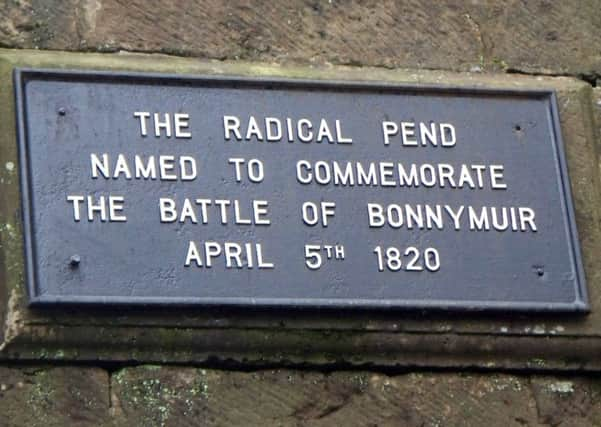Radicals' brave fight for rights at Bonnymuir


But we in Falkirk district know that the honour (if that is the right word) should really go to the clash which took place in the fields south of Bonnybridge on April 5, 1820.
At a time when we are preparing for an election in which all adults have a vote it is worth recalling the long and bitter struggle that paved the way for the privilege we often take for granted.
Advertisement
Hide AdAdvertisement
Hide AdAt that time power lay in the hands of a small group of property owners, around 3000, in the whole of Scotland, and they had no intention of giving up their ancient rights. All previous attempts at reform had met with penal laws and armed force but the determination to fight for what was right remained strong.
The men who stood, pikes in hand, facing the charging dragoons of the 10th Hussars and the Stirlingshire Yeoman Cavalry were mostly weavers from Glasgow and Condorrat en route – or so they thought – to meet up with the radical nailers of Camelon before marching to Carron Iron Works. Led by John Baird and Andrew Hardie their aim was to remove the cannons and take them to Glasgow as part of a plan to seize the city.
But the British Government was well ahead of them. Falkirk district had been swarming with soldiers, both regular and militia, for weeks and within the ranks of the radicals was an agent provocateur in the Government’s pay who led them to Bonnymuir.
He promised to bring the nailers from Camelon to rendezvous on the moor but instead alerted the dragoons based in Kilsyth. They rode to Bonnybridge and crossed under the canal through the Radical Pend before confronting Baird and Hardie’s men.
Advertisement
Hide AdAdvertisement
Hide AdThe poorly armed and trained weavers were no match for the soldiers and despite a brave fight they were eventually overwhelmed.
Eighteen men were taken to Stirling Castle as prisoners and elsewhere another 20 or so known radicals were rounded up and suffered the same fate.
The trials that followed offered supporters of reform an opportunity to make the case for change but as the court transcripts show they got short shrift from the judge who made it clear that their actions threatened all that was precious to the nation!
Despite the hostility of the court, a number of the men on trial were found not guilty but 22 were sentenced to death for treason or sedition.
Advertisement
Hide AdAdvertisement
Hide AdAll but Baird and Hardie had their sentences reduced and were sent instead to Australia as convicts.
The two leaders were executed in Broad Street, Stirling, in a bizarre fashion which saw them hanged and then have their heads chopped off after death, a fate reserved for traitors!
A decade later the Great Reform Act was passed by Parliament and though it was far from what the Radicals wanted it began the process which transformed the political system in a way that would have shocked the 1820 judges.
Many of the exiled men returned home but some had made a successful life on the other side of the world and had no wish to come back to the oppression that was the fate of so many.
Advertisement
Hide AdAdvertisement
Hide AdA few years ago a stone was erected by the 1820 society and others up on the B816 Bonnyhill Road near the field of action which stands as a reminder to us all that if we decide not to bother voting we are throwing away a very hard won privilege.